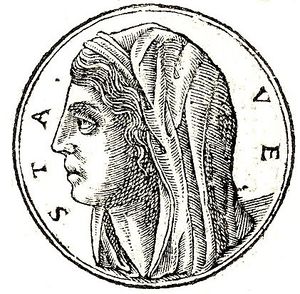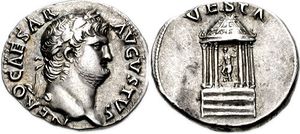ڤستا (أسطورة)
| Vesta | |
|---|---|
 | |
| المسكن | Forum Romanum |
| الرمز | The hearth and its fire |
| الأعياد | Vestalia (7–15 June) |
| معلومات شخصية | |
| الأبوان | Saturn and Ops |
| الأشقاء | Jupiter, Neptune, Pluto, Juno, Ceres |
| الآلهة المكافئة | |
| المكافئ اليوناني | هستيا |
ڤستا (Vesta ؛ نطق اللاتينية: [ˈwɛsta]) هي إلهة عذراء of the hearth, home, and family in Roman religion. She was rarely depicted in human form, and was often represented by the fire of her temple in the Forum Romanum. Entry to her temple was permitted only to her priestesses, the Vestals, who tended the sacred fire at the hearth in her temple. As she was considered a guardian of the Roman people, her festival, the Vestalia (7–15 June), was regarded as one of the most important Roman holidays.[1] During the Vestalia matrons walked barefoot through the city to the sanctuary of the goddess, where they presented offerings of food. Such was Vesta's importance to Roman religion that hers was one of the last republican pagan cults still active following the rise of Christianity until it was forcibly disbanded by the Christian emperor Theodosius I in AD 391.
The myths depicting Vesta and her priestesses were few, and were limited to tales of miraculous impregnation by a phallus appearing in the flames of the hearth—the manifestation of the goddess.[2] Vesta was among the Dii Consentes, twelve of the most honored gods in the Roman pantheon.[3] She was the daughter of Saturn and Ops, and sister of Jupiter, Neptune, Pluto, Juno, and Ceres. Her closest Greek equivalent is Hestia.[4]
أصل الاسم
| الدين في روما القديمة |
|---|
 |
| ممارسات واعتقادات |
| الكهانة |
| الآلهة |
الأباطرة المؤلهون: |
| موضوعات متعلقة |
Ovid derived Vesta from Latin vi stando – "standing by power". Cicero supposed that the Latin name Vesta derives from the Greek Hestia, which Cornutus claimed to have derived from Greek hestanai dia pantos ("standing for ever"). This etymology is offered by Servius as well.[5] Another etymology is that Vesta derives from Latin uestio ("clothe"), as well as from Greek έστἰα ("hearth" = focus urbis).[6]
Georges Dumézil (1898–1986), a French comparative philologist, surmised that the name of the goddess derives from Proto-Indo-European root *h₁eu-, via the derivative form *h₁eu-s- which alternates with *h₁w-es-.[7][8] The former is found in Greek εὕειν heuein, Latin urit, ustio and Vedic osathi all conveying 'burning' and the second is found in Vesta. (Greek goddess-name Ἑστία Hestia is probably unrelated).[9] See also Gallic Celtic visc "fire."
التاريخ
الأصل
According to tradition, worship of Vesta in Italy began in Lavinium, the mother-city of Alba Longa and the first Trojan settlement. From Lavinium worship of Vesta was transferred to Alba Longa. Upon entering higher office, Roman magistrates would go to Lavinium to offer sacrifice to Vesta and the household gods the Romans called Penates. The Penates were Trojan gods first introduced to Italy by Aeneas. Alongside those household gods was Vesta, who has been referred to as Vesta Iliaca (Vesta of Troy),[10] with her sacred hearth being named Ilaci foci (Trojan hearth).[11]
Worship of Vesta, like the worship of many gods, originated in the home, but became an established cult during the reign of either Romulus,[12] or Numa Pompilius[13] (sources disagree, but most say Numa).[14] The priestesses of Vesta, known as Vestal Virgins, administered her temple and watched the eternal fire. Their existence in Alba Longa is connected with the early Roman traditions, for Romulus' mother Silvia was a priestess.[15]
الامبراطورية الرومانية
التصوير
الزواج
المعبد
عذارى ڤستا
الأعياد
تصوير الأسطورة
Vesta had no official mythology, and she existed as an abstract goddess of the hearth and of chastity.[16] Only in the account of Ovid at Cybele's party does Vesta appear directly in a myth.[17]
مولد رومولوس وريموس
Plutarch, in his Life of Romulus, told a variation of Romulus' birth citing a compilation of Italian history by a Promathion. In this version, while Tarchetius was king of Alba Longa, a phantom phallus appeared in his hearth. The king visited an oracle of Tethys in Etrusca, who told him that a virgin must have intercourse with this phallus. Tarchetius instructed one of his daughters to do so, but she refused sending a handmaiden in her place. Angered, the king contemplated her execution; however, Vesta appeared to him in his sleep and forbade it. When the handmaid gave birth to twins by the phantom, Tarchetius handed them over to his subordinate, Teratius, with orders to destroy them. Teratius instead carried them to the shore of the river Tiber and laid them there. Then a she-wolf came to them and breastfed them, birds brought them food and fed them, before an amazed cow-herder came and took the children home with him. Thus they were saved, and when they were grown up, they set upon Tarchetius and overcame him.[18][19] Plutarch concludes with a contrast between Promathion's version of Romulus' birth and that of the more credible Fabius Pictor which he describes in a detailed narrative and lends support to.[20]
حمل سرڤيوس توليوس
انظر أيضاً
- Clerical celibacy
- House of the Vestals
- Temple of Vesta, Tivoli
- 4 Vesta, one of the largest objects in the asteroid belt
المراجع
- ^ Dixon-Kennedy 1998, p. 318
- ^ Schroeder 1998, pp. 335–336
- ^ Williams 2008, p. 11
- ^ Geffcken, Dickison & Hallett 2000, pp. 537–538
- ^ Frazer 1929, p. 299
- ^ Paschalis 1977, p. 78
- ^ Dumézil 1974, part 2, chap. 2
- ^ Beneviste 1969 (glottologist Émile Benveniste speaks on Georges Dumézil's theory)
- ^ Beekes 2010, pp. 471–472
- ^ Ovid Fasti vi. 265
- ^ Noehden 1817, p. 214
- ^ Beard, North & Price 1998, pp. 189–190 vol. 1, note no. 77: Plutarch, Life of Romulus 22; Dionysius of Halicarnassus, Roman Antiquities II.64.5–69
- ^ Beard, North & Price 1998, pp. 189–190 vol. 1, note no. 77: Virgil, Aeneid II.296, 597; Ovid, Fasti I.527-8, III.29, VI.227;Metamorphoses XV.730; Propertius IV.4.69; Dionysius of Halicarnassus, Roman Antiquities II.65.2
- ^ Williams 2008, p. 20
- ^ William Smith A Dictionary of Greek and Roman Antiquities [Retrieved 5/4/2015]
- ^ Newlands 1995, pp. 129–136
- ^ Newlands 1995, pp. 136–138
- ^ Plutarch, Life of Romulus, 2.3–6
- ^ Deroux 2008, p. 41
- ^ Wiseman 1995, p. 57
المصادر القديمة
- Gaius Valerius Catullus in Carmina
- Marcus Tullius Cicero in Pro Fonteio
- Dionysius of Halicarnassus in Romaike Archaiologia
- Gaius Acilius in Annales Aciliani
- Aulus Gellius in Noctes Atticae
- Maurus Servius Honoratus in In Vergilii Aeneidem commentarii
- Maurus Servius Honoratus in Eclogues
- Publius Ovidius Naso in Amores
- Publius Ovidius Naso in Fasti
- Gaius Petronius Arbiter in Satyricon
- Titus Maccius Plautus in Casina
- Gaius Plinius Secundus in Naturalis Historia
- Lucius Mestrius Plutarchus in Life of Numa
- Lucius Mestrius Plutarchus in Life of Romulus
المصادر الحديثة
- Beard, Mary; North, John; Price, Simon (1998), Religions of Rome:Volume 1, A History, Cambridge University Press, ISBN 0 521 30401 6
- Beard, Mary; North, John; Price, Simon (1998). Religions of Rome:Volume 2, A Sourcebook. Cambridge University Press. ISBN 0 521 45015 2.
- Beekes, Robert (2010), Etymological Dictionary of Greek, Leiden-Boston: Brill, ISBN 978-9004174184
- Benveniste, Émile (1969), Le vovabulaire des institutions indo-europeens, Paris: Éditions de Minuit
- Bowerstock, Glenn Warren; Brown, Peter; Grabar, Oleg (1999), Late Antiquity: A Guide to the Postclassical World, The Belknap Press of Harvard University Press, ISBN 978-0-674-51173-6
- Brulé, Pierre (1987) (in French), La Fille d'Athènes : la religion des filles à l'époque classique : mythes, cultes et société, Paris: Belles lettres, ISBN 978-2-25160-363-6
- Cecere, M. G. Granino (2003), Studi di Epigrafia Latina, 20
- Deroux, Carl (2008), Studies in Latin Literature and Roman History, 315, Latomus
- DiLuzio, Meghan J. (2016), A Place at the Altar: Priestesses in Republican Rome, Princeton University Press, ISBN 978-0-691-16957-6
- Dixon-Kennedy, Mike (1998), Encyclopedia of Greco-Roman Mythology, ISBN 978-1-57607-094-9
- Dubourdieu, Annie (1989) (in French), Les Origines et le développement du culte des pénates à Rome, École française de Rome, ISBN 978-2-72830-162-1
- Dumézil, Georges (1974), "2", La religion romaine archaïque, avec un appendice sur la religion des Étrusques, Paris: Payot, part 2
- Fraschetti, Augusto (2001), Roman Women, The University of Chicago Press, ISBN 9780226260938
- Frazer, James George (1929), Fastorum libri sex, IV, London: Macmillan and Co.
- Frothinghom, A. L. (1914). "Circular Templum and Mundus. Was the Templum Only Rectangular?". American Journal of Archaeology. 18.
{{cite journal}}: Invalid|ref=harv(help) - Geffcken, Katherine A.; Dickison, Sheila Kathryn; Hallett, Judith P. (2000), Rome and Her Monuments: Essays on the City and Literature of Rome in Honor of Katherine A. Geffcken, Wauconda, Illinois: Bolchazy-Carducci Publishers, ISBN 978-0-86516-457-4
- Hemelrijk, Emily (2015), Hidden Lives, Public Personae: Women and Civic Life in the Roman West, New York: Oxford University Press, ISBN 9780190251888
- Herbert-Brown, Geraldine (1994), Ovid and the Fasti: An Historical Study, Oxford: Clarendon Press Oxford, ISBN 978-0-19-814935-4
- Hersch, Karen K. (2010), The Roman Wedding: Ritual and Meaning in Antiquity, Cambridge University Press, ISBN 978-0-521-19610-9
- Johnston, Sarah Iles (2004), Religions of the Ancient World: A Guide, The Belknap Press of Harvard University Press, ISBN 978-0-674-01517-3
- Lefkowitz, Mary R.; Fant, Maureen B. (2005), Women's Life in Greece and Rome: A Source Book in Translation, Johns Hopkins University Press, ISBN 978-0-8018-8310-1, https://books.google.com/books?id=LV-FPLMeHgoC&pg=PA306
- Littlewood, R. Joy (2006), A Commentary on Ovid: Fasti book VI, Oxford; New York: Oxford University Press, ISBN 978-0-19927-134-4
- Marouzeau, Jules (2006) (in French), Revue des études latines, Société d'Édition Les Belles Lettres
- Middleton, John Henry (1886). "The Temple and Atrium of Vesta and the Regia". Archaeologia: 395.
{{cite journal}}: Invalid|ref=harv(help) هذا المقال يضم نصاً من هذا المصدر، الذي هو مشاع.
هذا المقال يضم نصاً من هذا المصدر، الذي هو مشاع. - Middleton, John Henry (1892), The Remains of Ancient Rome, 1, p. 295
 هذا المقال يضم نصاً من هذا المصدر، الذي هو مشاع.
هذا المقال يضم نصاً من هذا المصدر، الذي هو مشاع. - Morford, Mark P. O.; Lenardon, Robert J. (1999), Classical Mythology (Sixth ed.), Oxford University Press
- Mommsen, Theodor (1894), The History of Rome, I, https://books.google.com/?id=-EEZAAAAYAAJ&printsec=frontcover#v=onepage&q&f=false
 هذا المقال يضم نصاً من هذا المصدر، الذي هو مشاع.
هذا المقال يضم نصاً من هذا المصدر، الذي هو مشاع. - Newlands, Carole Elizabeth (1995), Playing with Time: Ovid and the Fasti, Volume 55, Cornell University Press, ISBN 978-0-8014-3080-0
- Noehden, G. H. (1817). "On the Worship of Vesta, and the Holy Fire, in Ancient Rome: with an Account of the Vestal Virgins". The Classical Journal. 15.
{{cite journal}}: Invalid|ref=harv(help) - Paschalis, Michael (1977), Virgil's Aeneid: Semantic Relations and Proper Names, Clarendon Press Oxford, ISBN 978-0-19-814688-9
- Salzman, Michele Rene (1990), On Roman Time: The Codex-Calendar of 354 and the Rhythms of Urban Life in Late Antiquity, University of California Press, ISBN 978-0-520-06566-6
- Schroeder, Jeanne Lorraine (1998), The Vestal and the Fasces: Hegel, Lacan, Property, and the Feminine, London: University of California Press, ISBN 978-0-520-21145-2
- Severy, Beth (2003), Augustus and the Family at the Birth of the Roman Empire, ISBN 978-0-203-21143-4
- Thédenat, Henry (1908) (in French), Le Forum romain et les forums impériaux, Paris: Hachette et Cie
- Watkin, David (2009), The Roman Forum, Harvard University Press, ISBN 978-0-674-03341-2
- Williams, Rome (2008), The Original Dysfunctional Family: Basic Classical Mythology for the New Millennium, ISBN 978-0-86516-690-5
- Wiseman, Timothy Peter (1995), Remus: A Roman Myth, Cambridge University Press, ISBN 0 521 41981 6





